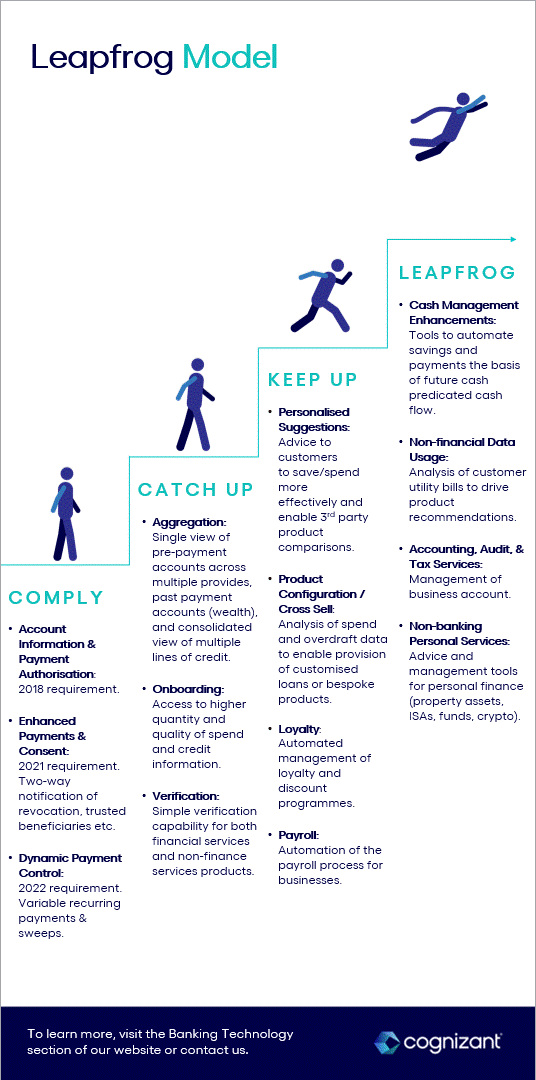
Moving beyond finance requirements to open banking styles-h2 text-white
<p><span class="medium"><br>March 24, 2022</span></p>
Moving beyond finance requirements to open banking
<p><b>The time is right for the UK’s largest banks to move beyond regulatory requirements to reap the strategic rewards of open finance. We share a four-step model to help show the way.</b></p>
<p>The UK’s largest banks are meeting the challenge to enable open banking in the UK by delivering against the foundational, regulatory requirements set by the Financial Conduct Authority (FCA) and the UK Government. The largest nine banks, as determined by the Competition and Markets Authority (CMA) — and referred to collectively as the CMA9 — have overcome significant procedural and technological challenges to offer new services to consumers and businesses, underpinned by a new capacity to make payments, share account data, and manage consents via trusted third-party providers and each bank’s own interfaces.</p> <p>The resulting growth in the fintech sector has been rapid, with the UK taking the lead: An estimated 50% of UK small businesses and four million consumers are using services enabled by open banking technology, according to the <a href="https://www.gov.uk/government/publications/update-governance-of-open-banking/update-on-open-banking" target="_blank" rel="noopener noreferrer">CMA</a>. In light of this growth, and with the implementation phase of open banking coming to an end this year, it is increasingly important for CMA9 banks to shift focus from compliance to the strategic benefits of <a href="/content/cognizant-dot-com/us/en/insights/perspectives/open-banking-unleashed-or-is-it.html" target="_blank" rel="noopener noreferrer">open banking</a> if they are to retain customers and keep pace with an increasingly sophisticated market.</p> <h4>The strategic gap</h4> <p>CMA9 banks well understand the strategic importance of open finance, both in terms of the opportunities it offers to improve services to existing customers and to increase market share by reaching new ones, as well as the potential costs of failing to match innovation by competitors in the marketplace. However, there has been little divergence among CMA9 banks on open banking strategy and, as a group, large banks are taking relatively modest steps to provide services or access beyond those required by regulation.</p> <p>To date, the largest banks have made progress towards allowing consumers and businesses to access an aggregated view of their financials across multiple providers, and some are beginning to achieve loyalty rewards for customers as well as improved savings advice. However, only two are going further by, for example, delivering bespoke lending based on data analysis, and there is little progress against other areas of growth and service potential, from automation of payroll for businesses to enabling customers to save money on bills or maximise their cash or property assets.</p> <p>Moreover, while large banks have shared a similar strategic approach to open banking thus far, execution of that strategy varies from bank to bank. This has resulted in significant differences in the quality of customer experiences offered: the number of clicks and time taken to access a given service online varies widely among CMA9 banks for the same task. This suggests the opportunity to build competitive capability simply by improving access to existing services and streamlining the customer experience, as well as by considering the best fit for each bank between their services, customer base and the opportunities of pushing further into open finance. Fintechs and new entrants to the market, such as Starling, Klarna and Revolut, are showing the way in this respect by placing a seamless, intuitive customer experience at the heart of their offer and operations.</p> <h4>Towards a new strategy</h4> <p>In our work on open banking, we find that clients can experience the sheer number of potential interventions to be overwhelming. This alone may have impeded their progress, not least given the often significant development costs associated with new products and technology, alongside managing the implications of legacy technology and the practical and reputational consequences attached to the need to protect data security.</p> <p>Emphasising two principles is therefore key in establishing a strategy for open banking that goes beyond regulatory requirements:</p> <ul> <li>Prioritisation, based on an understanding of existing customer journeys with the bank in relation to its existing and potential product offering.<br> <br> </li> <li>Market insights, or detailed knowledge of what competitors are offering CMA9 banks’ customers, such as personal financial management products that consolidate multiple lines of credit into a single view, or automating the payment of parking and toll charges via an app on a customer’s mobile phone.</li> </ul> <p>We developed a four-step “leapfrog” model that helps CMA9 banks grapple with both of these principles by taking a bespoke approach to reap the rewards and address the challenges of open banking. Based on our research, expertise and client engagements, we have grouped open banking interventions into four categories of increasing strategic and competitive benefit. These categories comprise a model that is helping large banks:</p> <ol> <li><b>Comply </b>with regulatory requirements, such as by providing trusted parties with seamless access to account information and payment authorization<br> <br> </li> <li><b>Catch up</b> with increasingly common services in the marketplace, such as simple international transfer of funds<br> <br> </li> <li><b>Keep up</b> with competitors who are drawing ahead, such as by participating in third-party financial services platforms<br> <br> </li> <li><b>Leapfrog</b> competitors, through the intelligent analysis of customer spending to enable flexible deployment of deposits, or to achieve savings through product recommendations</li> </ol> <p>Our experience on both sides of the open banking equation has helped our clients achieve and act on these insights. Using the leapfrog model, we have helped a client prioritise and sequence its open banking initiatives to deliver optimal returns. Working with the client, we have reduced over 50 possible new product features and service enhancements to three customer pathways. These pathways deliver tangible results that address specific customer issues. The result is a clear, focused and actionable plan for the next 18 months that will secure our client a place towards the front of the market leaders.</p>

#
<h4><b><br> </b>Navigating cultural change</h4> <p>The market insights that underpin this model also have an important role in helping CMA9 banks build a case for cultural change where it enables greater reach. Whilst offering products such as mortgages via a third-party platform like <a href="https://mortgageengine.com/" target="_blank" rel="noopener noreferrer">Mortgage Engine</a> can demand a new level of transparency from CMA9 banks on pricing and sales figures, including to competitors, establishing the number of customers who manage their personal finances through such platforms and receiving data that can drive product development can offer clear and quantifiable strategic benefits that more than justify this shift.</p> <p>Similarly, we have found that digital banks are more forward-thinking in their embrace of open finance tool development than CMA9 banks. However, use of the “leapfrog” model can help CMA9 banks determine the areas in which such approaches can fit with strategic priorities and therefore be mutually beneficial.</p> <h4>The unique strengths of CMA9 banks</h4> <p>Whilst smaller financial services companies can rely on agility and a lower regulatory burden, any open banking strategy built on this model will acknowledge the unique strengths of CMA9 banks’ operating models. There is a synergy between large banks’ reputational investment in protecting customer data and financial assets and the concern among many consumers about the risks of open banking.</p> <p>By embracing this model, CMA9 banks can combine the innovative, customer-centred logic of open banking with traditional banks’ essential and abiding attributes, including global reach, physical infrastructure and the sense of responsibility that comes with the highly local, highly personal service that major financial institutions still stand for. Traditional banks remain in a unique position to take a leap that others cannot.</p> <p>When bonding physical and digital interactions, CMA9 banks can reclaim the branch experience to coach customers in the use of open banking. This will pay dividends by:</p> <ul> <li>Enabling customers to drive their own financial improvement by providing them with tools, platforms and relationships that allow them to take control<br> <br> </li> <li>Helping customers understand their present financial situation and future potential, leveraging relationships to provide the insights, products and reassurance that those who are new to open banking may need<br> <br> </li> <li>Navigating the changing and sometimes turbulent fiscal environment with the continual enrichment of the customer as the guiding principle, providing products, services and partnerships that transcend banking’s traditional boundaries and build financial well-being<br> <br> </li> <li>Protecting customers in the widest sense, not only from security risks but also financial mishap, including as a result of malicious action, mis-selling or financial overextension</li> </ul> <p>Effective prioritisation and market insight are the first steps towards maximising the strategic potential of open banking. A nuanced understanding of the customer journey, the aspects of open banking with which customers are engaging most fully and an evolution of the role of the traditional bank will ensure CMA9 banks’ competitiveness in an increasingly agile market while consolidating those aspects of their offer that customers value the most.</p> <p><i>To learn more, visit </i><a href="https://www.cognizant.com/us/en/industries/banking-technology-solutions" target="_blank" rel="noopener noreferrer"><i>Banking Technology</i></a><i> section of our website or </i><a href="/content/cognizant-dot-com/us/en/about-cognizant/contact-us.html" target="_blank" rel="noopener noreferrer"><i>contact us</i></a><i>.</i></p> <p><i>This article was written by Daniel Meere, Head of BFS Consulting, GGM, Cognizant.</i></p>
<p>We’re here to offer you practical and unique solutions to today’s most pressing technology challenges. Across industries and markets, get inspired today for success tomorrow.</p>
